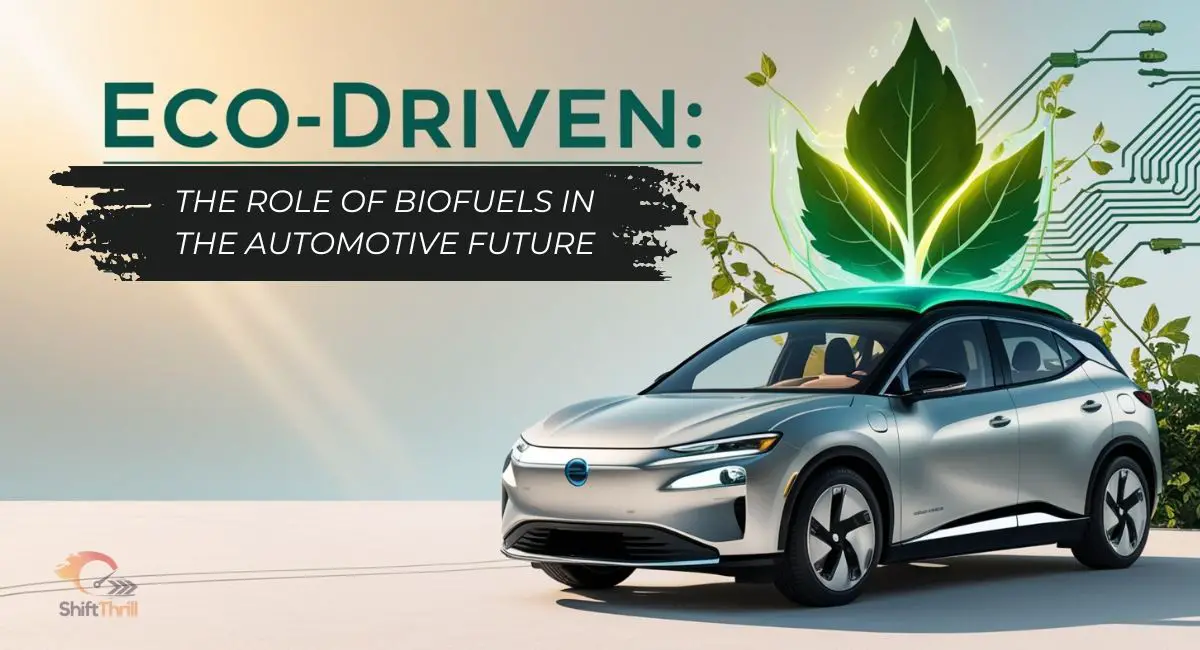As the world faces the pressing issue of climate change, the automotive industry is under increasing pressure to shift away from fossil fuels to more sustainable energy sources. Biofuels, derived from organic materials, have become a key player in this transformation. Biofuels offer a cleaner alternative to gasoline and diesel, making them an attractive option for eco-conscious drivers and automakers. This article takes a deep dive into biofuels, their benefits, the challenges they face, and their potential to revolutionize the future of transportation.
What Are Biofuels?
Simply put, biofuels are renewable fuels made from organic matter like plants, algae, and waste. Unlike fossil fuels, which take millions of years to form, biofuels can be produced in much shorter time frames, making them a more sustainable option.
Biofuels are divided into different generations based on how they are produced and their environmental impact:
- First-Generation Biofuels: Made from food crops such as corn, sugarcane, and soybeans. These include ethanol and biodiesel.
- Second-Generation Biofuels: Produced from non-food biomass like agricultural residues and wood, aiming to reduce competition with food crops.
- Third-Generation Biofuels: Made from algae, offering a high energy yield without using food crops or arable land.
- Fourth-Generation Biofuels: These are produced using advanced technologies like carbon capture and storage, making them carbon-negative (they remove more carbon from the atmosphere than they produce).
How Are Biofuels Made?
Biofuels are produced through various processes, depending on the type of fuel:
- Ethanol: Made by fermenting sugar or starch-based crops like corn and sugarcane. The sugars are converted into alcohol through fermentation and distillation.
- Biodiesel: Produced by mixing vegetable oils or animal fats with alcohol in a process called transesterification, creating biodiesel and glycerin.
- Algae-Based Fuels: Algae are grown in controlled environments, harvested, and processed into oils, which are then converted into biodiesel or ethanol.
Why Biofuels Matter for Cars
The automotive sector is one of the largest contributors to global greenhouse gas emissions. Biofuels have emerged as a viable solution to reduce these emissions while still fueling vehicles. Let’s explore how biofuels are beneficial to the automotive world.
1. Environmental Benefits
Biofuels help to reduce the overall carbon footprint of the transportation sector. For instance, ethanol can cut emissions by 34-44% compared to gasoline, and biodiesel can reduce emissions by up to 86%. They also produce fewer pollutants like particulates and sulfur oxides, which improve air quality, especially in urban areas.
2. Economic Advantages
Biofuels are not only better for the environment but also for the economy. They create jobs in agriculture, biofuel production, and distribution. In fact, the global biofuels market supported over 2 million jobs in 2022, particularly in rural areas where biofuel crops are grown. Additionally, biofuels reduce dependence on oil imports, helping countries become more energy independent.
3. Compatibility with Existing Engines
One of the key advantages of biofuels is that they are easy to integrate into existing vehicles. Most cars today can run on E10 (10% ethanol) and B20 (20% biodiesel) without any significant modifications. Flex-fuel vehicles, which can run on higher ethanol blends like E85, are also becoming more common.
Challenges of Biofuels
While biofuels offer numerous benefits, there are still challenges to their widespread adoption. Let’s take a look at some of these challenges:
1. Environmental Concerns
- Land Use and Deforestation: Growing crops for biofuels requires large amounts of land, which can lead to deforestation and habitat destruction. Palm oil plantations in Southeast Asia are a prime example, as they have been linked to significant environmental damage.
- Water Usage: Growing biofuel crops like sugarcane and corn requires a lot of water, which can stress local water resources.
2. Economic and Logistical Challenges
- Producing biofuels, especially advanced ones, can be expensive. While costs are expected to decrease over time, biofuels remain more expensive than fossil fuels in many regions.
- Infrastructure for biofuel storage and distribution is still limited in some parts of the world, hindering widespread adoption.
3. Social Impacts
- The “food vs. fuel” debate is a major concern. Using food crops like corn for biofuel production can drive up food prices, particularly in developing countries where food security is already a challenge.
- Large-scale biofuel farming can displace local communities, leading to social conflicts and displacement.
4. Technological Challenges
- Scaling up algae-based biofuels remains a challenge due to high production costs and complex growing conditions.
- Some biofuels, particularly biodiesel, can have performance issues in cold weather, as they may gel at low temperatures.
Innovations in Biofuel Technology
To overcome the challenges and make biofuels more viable, researchers and engineers are constantly innovating. Here are some key advancements in biofuel technology:
1. Algae-Based Biofuels
Algae are an exciting option for biofuel production because they can be grown in places where food crops can’t, such as non-arable land or even wastewater. Algae can also absorb CO2 as they grow, making them a potential carbon sink. However, large-scale algae biofuel production remains expensive, and more research is needed to make it more cost-effective.
2. Genetically Modified Crops
Researchers are working on developing genetically modified crops that are more resistant to pests, drought, and diseases. These crops would require fewer resources and less land, making biofuel production more sustainable.
3. Waste-to-Energy
Another innovative approach involves converting waste materials—such as municipal solid waste, agricultural residues, or even used cooking oil—into biofuels. This reduces waste while producing energy, providing a more sustainable alternative to traditional biofuels.
4. Carbon-Negative Biofuels
By integrating carbon capture and storage (CCS) technologies, biofuels can become carbon-negative, meaning they remove more carbon from the atmosphere than they emit. This could play a crucial role in helping industries meet net-zero emissions targets.
Global Case Studies: Successful Biofuel Initiatives
Biofuels are being adopted across the globe with varying degrees of success. Let’s look at a few case studies:
1. Brazil’s Ethanol Success
Brazil is a world leader in ethanol production, using sugarcane as the main feedstock. More than 80% of vehicles in Brazil are capable of running on ethanol, which has significantly reduced the country’s reliance on fossil fuels.
2. The U.S. Renewable Fuel Standard (RFS)
In the United States, the Renewable Fuel Standard mandates that a certain amount of ethanol and biodiesel be blended into the fuel supply. This policy has led to a significant reduction in greenhouse gas emissions and created jobs in the renewable energy sector.
3. Europe’s Biodiesel Program
Countries like Germany and France have adopted biodiesel as a significant part of their fuel supply. Biodiesel is made primarily from crops like rapeseed and sunflower oil, contributing to a cleaner transportation sector.
4. India’s Ethanol Blending Program
India plans to blend 20% ethanol into its gasoline supply by 2025, which would help reduce oil imports and cut down on emissions. This initiative is set to play a critical role in the country’s transition to renewable energy.
Comparing Biofuels with Other Green Technologies
Biofuels are part of a broader movement toward sustainable transportation. How do they stack up against other alternatives like electric vehicles (EVs) and hydrogen fuel cells?
1. Biofuels vs. Electric Vehicles
- EVs are zero-emission vehicles, but they require a significant amount of energy to produce and dispose of their batteries.
- Biofuels are easier to integrate into existing internal combustion engine (ICE) vehicles, and they can provide a transitional solution for fleets and regions where EV infrastructure is lacking.
2. Biofuels vs. Hydrogen Fuel Cells
- Hydrogen offers high efficiency and zero emissions, but the technology is still in its early stages, and there are challenges with hydrogen storage and infrastructure.
- Biofuels are already compatible with most current vehicle engines and are likely to remain a part of the energy mix for the foreseeable future.
Government Support for Biofuels
Governments worldwide are recognizing the importance of biofuels in their energy and climate goals.
- Subsidies and Incentives: Many countries provide financial incentives for biofuel production and consumption, such as tax credits and blending mandates.
- International Commitments: Biofuels are an essential part of global climate agreements like the Paris Agreement. Countries like the U.S., Brazil, and India are ramping up their biofuel production to meet emission reduction targets.
The Road Ahead: What’s Next for Biofuels?
The biofuel industry is set for growth in the coming decades. According to market projections, the biofuels market will reach $250 billion by 2030. Technological advancements and more sustainable feedstocks are making biofuels increasingly viable. Additionally, biofuels will play a significant role in decarbonizing hard-to-electrify sectors like aviation and shipping.
In conclusion, biofuels offer a powerful, eco-friendly solution to the automotive industry’s emissions problem. As technology improves and global demand for renewable energy rises, biofuels will continue to play a key role in driving the world toward a more sustainable future.

